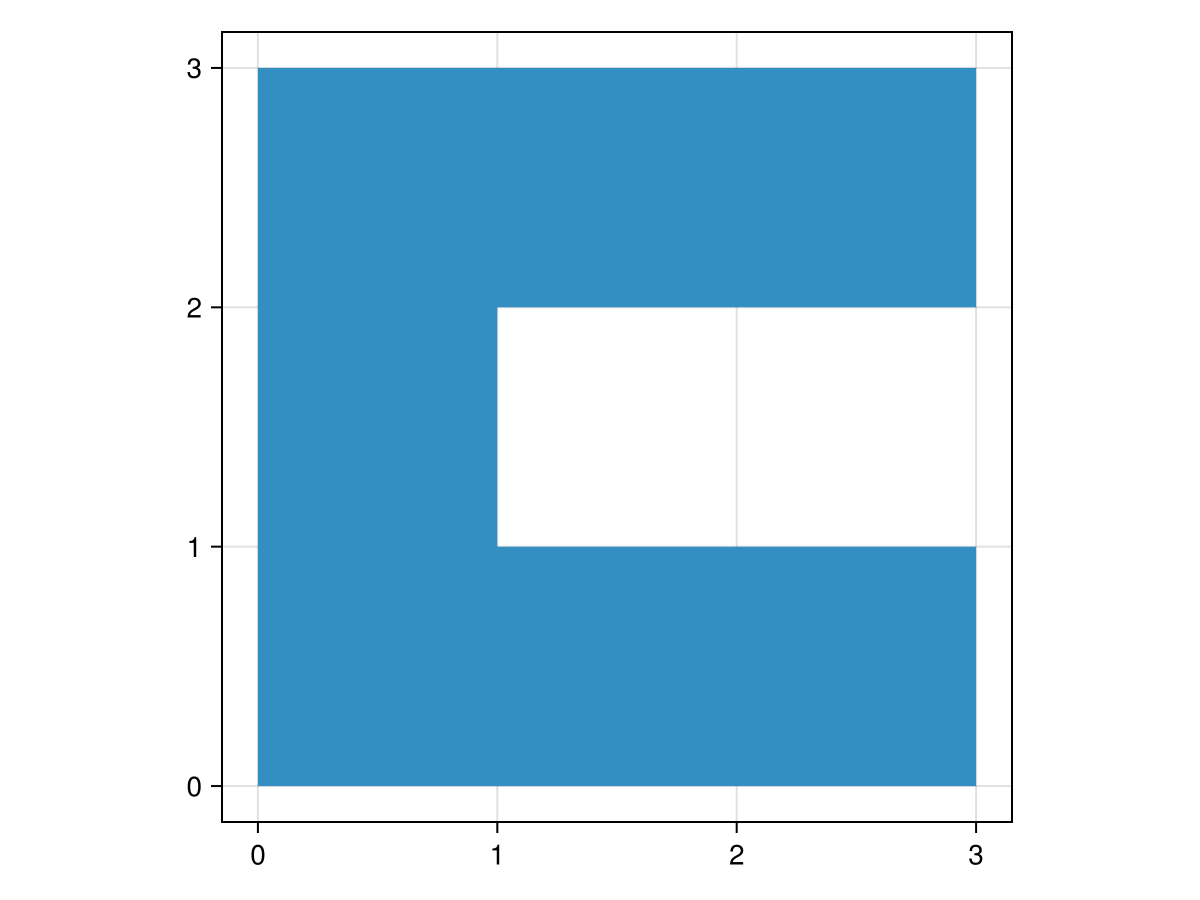Centroid
export centroid, centroid_and_length, centroid_and_areaWhat is the centroid?
The centroid is the geometric center of a line string or area(s). Note that the centroid does not need to be inside of a concave area.
Further note that by convention a line, or linear ring, is calculated by weighting the line segments by their length, while polygons and multipolygon centroids are calculated by weighting edge's by their 'area components'.
To provide an example, consider this concave polygon in the shape of a 'C':
import GeometryOps as GO
import GeoInterface as GI
using Makie
using CairoMakie
cshape = GI.Polygon([[(0,0), (0,3), (3,3), (3,2), (1,2), (1,1), (3,1), (3,0), (0,0)]])
f, a, p = poly(collect(GI.getpoint(cshape)); axis = (; aspect = DataAspect()))
Let's see what the centroid looks like (plotted in red):
cent = GO.centroid(cshape)
scatter!(GI.x(cent), GI.y(cent), color = :red)
f
Implementation
This is the GeoInterface-compatible implementation.
First, we implement a wrapper method that dispatches to the correct implementation based on the geometry trait. This is also used in the implementation, since it's a lot less work!
Note that if you call centroid on a LineString or LinearRing, the centroid_and_length function will be called due to the weighting scheme described above, while centroid_and_area is called for polygons and multipolygons. However, centroid_and_area can still be called on a LineString or LinearRing when they are closed, for example as the interior hole of a polygon.
The helper functions centroid_and_length and centroid_and_area are made available just in case the user also needs the area or length to decrease repeat computation.
"""
centroid(geom, [T=Float64])::Tuple{T, T}
Returns the centroid of a given line segment, linear ring, polygon, or
mutlipolygon.
"""
centroid(geom, ::Type{T} = Float64; threaded=false) where T =
centroid(GI.trait(geom), geom, T; threaded)
function centroid(
trait::Union{GI.LineStringTrait, GI.LinearRingTrait}, geom, ::Type{T}=Float64; threaded=false
) where T
centroid_and_length(trait, geom, T)[1]
end
centroid(trait, geom, ::Type{T}; threaded=false) where T =
centroid_and_area(trait, geom, T; threaded)[1]
"""
centroid_and_length(geom, [T=Float64])::(::Tuple{T, T}, ::Real)
Returns the centroid and length of a given line/ring. Note this is only valid
for line strings and linear rings.
"""
centroid_and_length(geom, ::Type{T}=Float64) where T =
centroid_and_length(GI.trait(geom), geom, T)
function centroid_and_length(
::Union{GI.LineStringTrait, GI.LinearRingTrait}, geom, ::Type{T},
) where TInitialize starting values
xcentroid = zero(T)
ycentroid = zero(T)
length = zero(T)
point₁ = GI.getpoint(geom, 1)Loop over line segments of line string
for point₂ in GI.getpoint(geom)Calculate length of line segment
length_component = sqrt(
(GI.x(point₂) - GI.x(point₁))^2 +
(GI.y(point₂) - GI.y(point₁))^2
)Accumulate the line segment length into length
length += length_componentWeighted average of line segment centroids
xcentroid += (GI.x(point₁) + GI.x(point₂)) * (length_component / 2)
ycentroid += (GI.y(point₁) + GI.y(point₂)) * (length_component / 2)
#centroid = centroid .+ ((point₁ .+ point₂) .* (length_component / 2))Advance the point buffer by 1 point to move to next line segment
point₁ = point₂
end
xcentroid /= length
ycentroid /= length
return (xcentroid, ycentroid), length
end
"""
centroid_and_area(geom, [T=Float64])::(::Tuple{T, T}, ::Real)
Returns the centroid and area of a given geometry.
"""
function centroid_and_area(geom, ::Type{T}=Float64; threaded=false) where T
trait = GI.trait(geom)
centroid_and_area(trait, geom, T; threaded)
end
function centroid_and_area(trait, geom, ::Type{T}; threaded=false) where T
target = TraitTarget{Union{GI.PolygonTrait,GI.LineStringTrait,GI.LinearRingTrait}}()
init = (zero(T), zero(T)), zero(T)
applyreduce(WithTrait((trait, g) -> centroid_and_area(trait, g, T)), _combine_centroid_and_area, target, geom; threaded, init)
end
function centroid_and_area(
::Union{GI.LineStringTrait, GI.LinearRingTrait}, geom, ::Type{T}
) where TCheck that the geometry is closed
@assert(
GI.getpoint(geom, 1) == GI.getpoint(geom, GI.ngeom(geom)),
"centroid_and_area should only be used with closed geometries"
)Initialize starting values
xcentroid = zero(T)
ycentroid = zero(T)
area = zero(T)
point₁ = GI.getpoint(geom, 1)Loop over line segments of linear ring
for point₂ in GI.getpoint(geom)
area_component = GI.x(point₁) * GI.y(point₂) -
GI.x(point₂) * GI.y(point₁)Accumulate the area component into area
area += area_componentWeighted average of centroid components
xcentroid += (GI.x(point₁) + GI.x(point₂)) * area_component
ycentroid += (GI.y(point₁) + GI.y(point₂)) * area_componentAdvance the point buffer by 1 point
point₁ = point₂
end
area /= 2
xcentroid /= 6area
ycentroid /= 6area
return (xcentroid, ycentroid), abs(area)
end
function centroid_and_area(::GI.PolygonTrait, geom, ::Type{T}) where TExterior ring's centroid and area
exterior = GI.getexterior(geom)
(xcentroid, ycentroid), area = centroid_and_area(GI.geomtrait(exterior), exterior, T)Weight exterior centroid by area
xcentroid *= area
ycentroid *= areaLoop over any holes within the polygon
for hole in GI.gethole(geom)Hole polygon's centroid and area
(xinterior, yinterior), interior_area = centroid_and_area(GI.geomtrait(hole), hole, T)Accumulate the area component into area
area -= interior_areaWeighted average of centroid components
xcentroid -= xinterior * interior_area
ycentroid -= yinterior * interior_area
end
xcentroid /= area
ycentroid /= area
return (xcentroid, ycentroid), area
endThe op argument for _applyreduce and point / area It combines two (point, area) tuples into one, taking the average of the centroid points weighted by the area of the geom they are from.
function _combine_centroid_and_area(((x1, y1), area1), ((x2, y2), area2))
area = area1 + area2
x = (x1 * area1 + x2 * area2) / area
y = (y1 * area1 + y2 * area2) / area
return (x, y), area
endThis page was generated using Literate.jl.